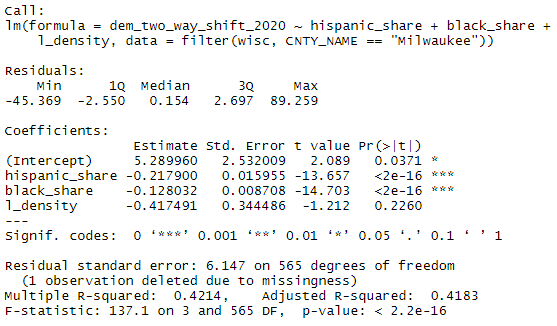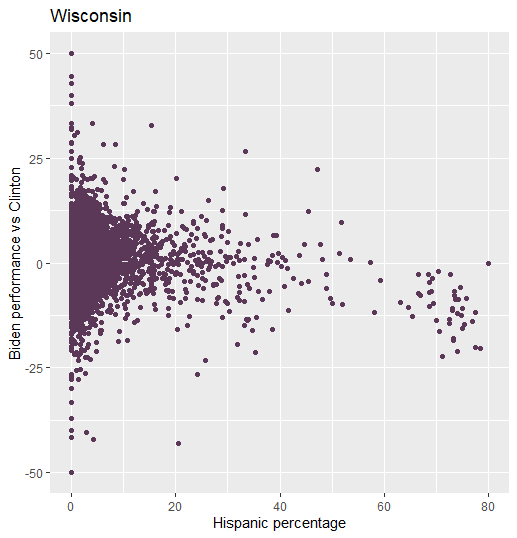There's a reason the RNC is opening a field office in a Hispanic area of Milwaukee
Republicans see 2020 gains with voters of color as an opportunity. Democrats shouldn't ignore this.
There’s been a lot of discussion regarding Democrats’ 2022 prospects in light of the Republican candidate winning the Virginia gubernatorial election and New Jersey’s Democratic governor only narrowly winning re-election. But there was another news story from a couple months ago that went largely unnoticed: in advance of next year’s Senate and Governor races in Wisconsin, the RNC is opening a field office in Milwaukee’s increasingly-Hispanic South Side. This comes after a presidential cycle where, despite losing re-election, Trump made relative gains with Hispanic voters.1 Though this phenomenon was most noticed and discussed with regard to South Florida and South Texas, the shift happened throughout the nation.
Republicans are taking note. Democrats should too.
Hispanics are a growing share of Wisconsin’s population
Analysis of Wisconsin’s emergence as a key swing state (it was the tipping point state in both 2016 and 2020) has focused primarily on the nationwide rightward shift of non-college educated white voters (especially in places like Wisconsin where Democrats had previously been competitive with this bloc), which make up a large portion of the state’s electorate. However, just like the rest of the nation, Wisconsin is becoming more ethnically diverse, which is particularly noticeable in its largest cities.
Milwaukee, the state’s most populous city, is majority-minority and contains a large portion of the state’s Democratic voters. Coverage of the city’s demographic and political history has tended to focus on the history of African Americans in the city; the Milwaukee metro area is among the nation’s most segregated and has extremely high disparities in life outcomes (particularly with regard to educational attainment and incarceration) between its white and Black residents.
More recently, Mexican American and Puerto Rican communities have been growing in the city’s South Side; according to the 2020 census, the city is now 20% Hispanic. Many of Wisconsin’s other major cities have experienced similar demographic changes: Green Bay, Kenosha, and Racine are now 18, 20, and 24% Hispanic, respectively.2
When political analysts talk about Hispanic voters in swing states, they tend to focus on states such as Arizona, Florida, Nevada, and Texas. But Wisconsin is becoming increasingly pivotal to American politics and Hispanic communities are growing in the cities that power Democratic victories in the state. And in a state that was decided by less than 25,000 votes in the last two presidential elections, every part of the party’s coalition is crucial.
Trump improved from 2016 to 2020 in the most Hispanic precincts in Wisconsin
Conveniently, Wisconsin has published election and demographic data from 2012 to 2020 with their current ward boundaries.3 Therefore, we can look at the most Hispanic wards in the state and see how they shifted. Unfortunately, there isn’t ward-by-ward data on educational attainment (which explains much of the changes from 2016 to 2020 nationwide and also acts as an important control). However, the patterns this data shows are still informative.
A regression that predicts the effect of a ward’s Hispanic percentage on the shift in Democrats’ two-way vote margin4 in the presidential race doesn’t have a high correlation, suggesting most of the shift in the state is explained by other factors. But the Hispanic percentage is a statistically significant negative predictor of how Biden performed in 2020 compared to Clinton in 2016.
Adding more variables, it also looks like a ward’s Black population share is also predictive of a decline for Biden relative to Clinton, and the effect of the Hispanic population share increases when accounting for population density.
And this model is significantly more predictive in Milwaukee County, where the RNC is opening their office. (Notably, density is not as predictive a variable here.) In the other Wisconsin counties with significant Hispanic populations, there’s a similar pattern, though with the exception of Racine, the correlation is not as high.5
Scatterplots show this isn’t just a case of Hispanics shifting less than the overall population towards Biden; most majority-Hispanic wards in Wisconsin shifted towards Trump in 2020, and this was especially stark in Milwaukee.
Republicans are serious about non-white outreach; Democrats should act accordingly
During Trump’s emergence as a major political figure, there were predictions that he would worsen the GOP’s struggles with non-white voters. And during his presidency, attempts at appealing to voters of color were often cast less as genuine outreach, but signaling to certain college educated white voters, who had previously supported Republicans but found Trump personally distasteful. And yet, by 2020, the coalition Trump assembled was significantly more racially diverse than the coalition Romney assembled in 2012, while Biden’s gains were specifically concentrated with those college educated white voters. And right-wing disinformation is becoming more prominent on non-English language social media, which means that conservative talking points could take up more oxygen in these communities if Democrats don’t make an effort to counter them.
To be clear: Democrats still won Hispanic voters by substantial margins in 2020, both in Wisconsin and nationwide. But in close elections, even slight drops in support with a coalition bloc can matter. Democrats should incorporate this into their strategy.
Quick note on terminology: I’ll be using the term “Hispanic” because it’s the term used in the sources for the data I used for this piece (“Hispanic” and “Latino / Latina / Latinx” are not entirely identical terms, though this piece focuses most on Mexican American and Puerto Rican communities, for whom both terms apply) and because it’s the term that most commonly used by the relevant population (at least, it’s the most commonly used umbrella term; the most common choice of identification is a specific nationality, which is why I’m also specifying the specific Hispanic groups that are most common in the state).
The Hispanic communities in these cities are mostly Mexican American and Puerto Rican, like in Milwaukee.
“Ward” is most often used to denote political subdivisions within cities, but Wisconsin uses the term statewide in the same way other states might use “precincts.” The fact that Wisconsin has election totals for previous elections are counted with the current ward boundaries avoids the problem of precinct boundaries changing from election to election, which makes comparisons much easier.
This excludes third parties, which is useful when we’re solely focusing on Democratic performance vs Republicans.









